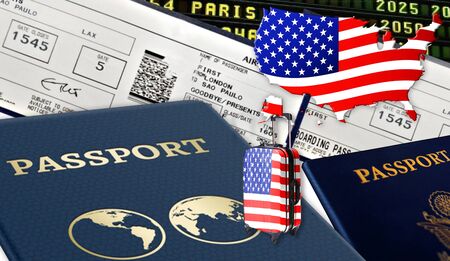Understanding Your Coverage
Before you embark on your international adventure, it’s essential to fully understand the details of your travel insurance policy. Reviewing your coverage ahead of time is one of the most important steps in ensuring a smooth and successful claim process should anything go wrong while you’re abroad. Start by reading through your policy documents carefully to know exactly what situations are covered—such as medical emergencies, trip cancellations, or lost luggage—and which are not.
Insurance providers in the U.S. often use specific terms and exclusions that can impact your claim eligibility. For example, certain policies might cover emergency medical treatment but exclude pre-existing conditions or adventure sports. Similarly, some plans will reimburse for trip interruptions caused by illness or natural disasters but not for changes due to personal reasons. Knowing these distinctions can save you time and frustration if you need to file a claim.
Below is a quick reference table summarizing common coverage areas and typical exclusions found in U.S.-based international travel insurance policies:
| Coverage Area | Usually Covered | Common Exclusions |
|---|---|---|
| Medical Emergencies | Accidents, sudden illnesses | Pre-existing conditions, elective procedures |
| Trip Cancellation/Interruption | Illness, injury, natural disasters | Change of mind, unapproved reasons |
| Lost Luggage | Theft, loss by airline/carrier | Unattended belongings, delayed reporting |
| Travel Delay | Weather, airline strikes | Lack of documentation, foreseeable events |
By understanding what your policy covers before you travel, you’ll be better prepared to collect the necessary documentation and follow proper procedures should you need to file a claim. Always keep a copy of your insurance details handy during your trip and don’t hesitate to contact your insurer’s customer service for clarification on any terms or benefits.
2. Gathering the Right Documentation
When filing an international travel insurance claim in the U.S., thorough documentation is key to ensuring a smooth process and maximizing your chances of approval. Insurance companies require clear evidence to validate your claim, so knowing exactly what to gather can make all the difference. Below is a breakdown of essential documents commonly requested for various types of claims:
| Type of Claim | Required Documentation |
|---|---|
| Medical Expenses |
|
| Theft or Loss of Property |
> |
| Trip Cancellation/Interruption |
|
The Dos and Don’ts When Collecting Evidence
Dos:
- Do act quickly: Gather and submit documentation as soon as possible after an incident.
- Do make copies: Keep both digital and hard copies of all documents for your own records.
- Do ensure accuracy: Double-check that all paperwork matches your personal details and policy information.
- Do translate documents if necessary: If any documents are in a language other than English, provide certified translations.
Don’ts:
- Don’t submit originals unless required: Always confirm with your insurer whether originals are needed; otherwise, send copies to avoid losing important paperwork.
- Don’t delay reporting: Waiting too long to file police reports or notify authorities can weaken your claim.
- Don’t omit supporting details: Lack of adequate documentation is a common reason for denial.
Cultural Tip:
In the U.S., insurance providers value clarity and transparency. Being organized, proactive, and detailed in your submission not only speeds up your claim but also demonstrates credibility. Remember, when in doubt, ask your insurer for a checklist of required documents before filing your claim.

3. Filing Your Claim Promptly
When it comes to international travel insurance claims, timing is everything. Submitting your claim as soon as possible after an incident can make the difference between a smooth reimbursement process and a denied claim. Most U.S.-based insurers have strict deadlines for filing claims, often ranging from 20 to 90 days after the event occurs. Missing these deadlines can result in automatic denial, regardless of the legitimacy of your claim.
To help you stay on track, here’s a quick overview of typical timelines and required actions:
Action |
Recommended Timeframe |
Why It Matters |
|---|---|---|
| Notify your insurer about the incident | Within 24-48 hours | Ensures your case is logged early and guidance is provided |
| Gather all supporting documents | Immediately after the incident | Documents are easier to obtain and more accurate right away |
| Submit your completed claim form and documents | Within insurer’s specified deadline (usually 20-90 days) | Avoids claim denial due to late submission |
Tips for Timely Filing:
- Check your policy: Know your provider’s specific deadlines before you travel.
- Set reminders: Use your phone or calendar apps to keep track of important dates.
- Keep copies: Always make digital and physical copies of receipts, medical reports, and communications.
- Communicate promptly: If you’re unable to submit immediately due to travel disruptions or emergencies, contact your insurer to explain and document any delays.
By acting quickly and staying organized, you maximize your chances for a successful claim and avoid unnecessary complications down the road.
Contacting Your Insurance Provider
Once you’ve gathered all the necessary documents and details, it’s time to reach out to your travel insurance provider. The way you communicate and follow up can have a major impact on the success of your claim. Here are some best practices and steps to help make the process as smooth as possible:
Best Practices for Reaching Out
Start by locating your policy number and any relevant contact information, usually found in your confirmation email or app. Contact your insurer as soon as possible after the incident, since many providers have strict timelines for reporting claims. Most American insurance companies offer several ways to get in touch—phone, online portals, email, or even mobile apps.
| Contact Method | Pros | Cons |
|---|---|---|
| Phone Call | Immediate feedback, direct answers to questions | Possible wait times, less documentation of conversation |
| Written record of communication, easy to attach documents | Slower response time, risk of email going to spam/junk folder | |
| Online Portal/App | User-friendly, track claim status, upload files instantly | Requires login and stable internet connection |
Communicating Clearly with Your Insurer
When you first make contact, be concise but thorough: explain who you are, what happened, when and where it occurred, and what type of coverage you’re seeking. Avoid jargon or assumptions that the agent knows every detail—clarity is key. If English isn’t your first language or you’re unsure about terms, don’t hesitate to ask for clarification or request a summary in writing.
Key Details to Provide When Contacting Your Insurer:
- Your full name and policy number
- Date and location of the incident or loss
- A brief summary of what happened (e.g., medical emergency, lost luggage)
- List of supporting documents you have ready (receipts, police reports, etc.)
- Your preferred method of follow-up (phone call or email)
Following Specific Claim Procedures
Every insurance company has its own set of procedures for filing a claim. Be sure to ask if there are specific forms that need to be filled out or if digital uploads are accepted. Some providers may require original receipts mailed in while others accept scanned copies. Keep records of all communication—including emails, phone logs with representative names, and any reference numbers provided.
DOS:
- Double-check deadlines for submitting paperwork and evidence.
- Follow up regularly but politely if you haven’t received confirmation.
- Keep copies of everything you send.
DON’TS:
- Don’t assume verbal conversations are enough—get everything in writing.
- Don’t delay reporting an incident; waiting too long can jeopardize your claim.
- Don’t provide incomplete or inconsistent information.
This organized approach to contacting your insurer will help avoid misunderstandings and ensure your claim moves forward efficiently.
5. Common Mistakes to Avoid
Filing an international travel insurance claim can be overwhelming, especially if you’re unfamiliar with the process or U.S. insurance norms. To help ensure your claim gets approved without unnecessary delays or denials, it’s important to steer clear of some common pitfalls. Below, we’ll identify typical mistakes travelers make and provide guidance on how to avoid them.
Typical Errors When Filing Travel Insurance Claims
| Mistake | Description | How to Avoid |
|---|---|---|
| Incomplete Documentation | Submitting claims without receipts, medical records, or proof of expenses. | Always gather and organize all relevant documents before filing your claim. |
| Missing Deadlines | Failing to submit your claim within the required time frame, typically 30-90 days after the incident. | Check your policy for deadlines and set reminders to file promptly. |
| Lack of Policy Understanding | Claiming for events or items not covered by your policy, such as pre-existing conditions or non-emergency treatments. | Read your policy thoroughly and contact your insurer if you’re unsure about coverage. |
| Poor Communication | Not responding quickly to requests for additional information from the insurance company. | Monitor your email and phone for updates and reply promptly to any queries from your insurer. |
| Incorrect Information | Providing inaccurate details about the incident or expenses, intentionally or unintentionally. | Double-check all forms for accuracy and honesty before submission. |
Additional Tips to Steer Clear of Pitfalls
- Keep Copies: Always make digital copies of all paperwork you submit in case something goes missing or is requested again.
- Avoid Double Dipping: Don’t file for reimbursement with multiple insurers for the same expense; this can be considered insurance fraud in the U.S.
- Follow Instructions: Each insurer may have unique procedures—follow their instructions carefully to prevent processing delays.
- Stay Professional: Communicate respectfully and keep a record of all correspondences with your insurance provider.
The Bottom Line
Avoiding these common mistakes can streamline your international travel insurance claim process and help ensure you get reimbursed quickly and efficiently. Take the time to understand your policy, stay organized, and communicate clearly to protect yourself financially while traveling abroad.
6. Following Up and Resolving Issues
After submitting your international travel insurance claim, the process isn’t always over. To maximize your chances of a successful outcome, you need to be proactive in following up and prepared to address any issues that may arise. Here’s how you can effectively manage the post-claim process:
Understanding Claim Timelines
Insurance companies usually provide an estimated time frame for processing claims. Make sure to note this timeline when you submit your claim. If you haven’t heard back by the end of the expected period, it’s appropriate to follow up.
Typical Claim Processing Timeline
| Claim Type | Expected Processing Time |
|---|---|
| Medical Emergency | 1–2 weeks |
| Baggage Loss/Delay | 1–3 weeks |
| Trip Cancellation/Interruption | 2–4 weeks |
Effective Follow-Up Strategies
If your claim is delayed or you need additional information, contact your insurer using their preferred communication method (phone, email, or online portal). Be sure to have your policy number and claim reference handy. Always document your interactions, including dates, names of representatives spoken to, and summaries of the conversation.
Addressing Denied or Delayed Claims
If your claim is denied or unnecessarily delayed, don’t panic. Review the insurer’s explanation carefully—sometimes additional documentation or clarification can resolve the issue quickly. If you believe your claim was wrongly denied, request a formal review or appeal in writing, referencing specific policy terms that support your case.
Sample Steps for Escalating Your Claim
| Step | Action |
|---|---|
| 1. Request Explanation | Ask for a detailed reason for denial or delay. |
| 2. Provide Additional Evidence | Submit extra documents if requested. |
| 3. File a Formal Appeal | Write an appeal letter with supporting evidence. |
| 4. Contact State Insurance Regulator | If unresolved, reach out to your states Department of Insurance. |
When to Escalate Further
If all else fails and you believe the insurer is not acting in good faith, consider filing a complaint with your state’s Department of Insurance or seeking legal advice from an attorney specializing in insurance claims. In most cases, persistence and clear communication are key to achieving resolution.
Navigating claim follow-ups can seem daunting but staying organized and assertive helps ensure you receive the coverage you’re entitled to under your international travel insurance policy.


